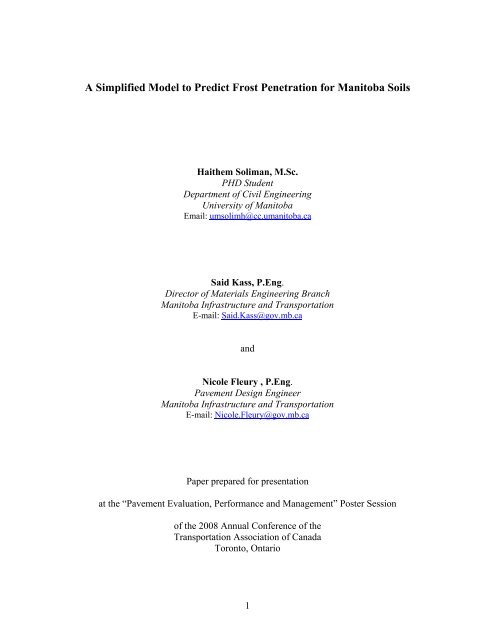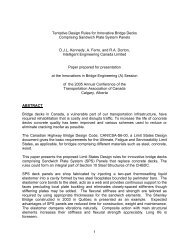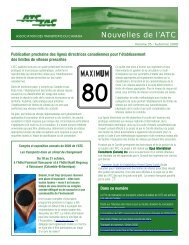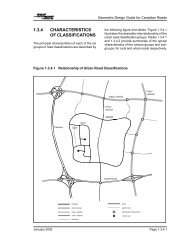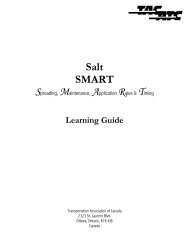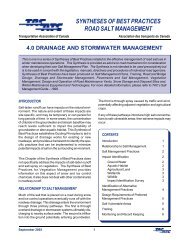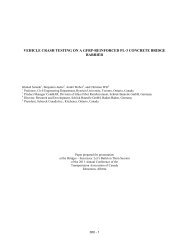A Simplified Model to Predict Frost Penetration for Manitoba Soils
A Simplified Model to Predict Frost Penetration for Manitoba Soils
A Simplified Model to Predict Frost Penetration for Manitoba Soils
Create successful ePaper yourself
Turn your PDF publications into a flip-book with our unique Google optimized e-Paper software.
A <strong>Simplified</strong> <strong>Model</strong> <strong>to</strong> <strong>Predict</strong> <strong>Frost</strong> <strong>Penetration</strong> <strong>for</strong> Mani<strong>to</strong>ba <strong>Soils</strong><br />
Haithem Soliman, M.Sc.<br />
PHD Student<br />
Department of Civil Engineering<br />
University of Mani<strong>to</strong>ba<br />
Email: umsolimh@cc.umani<strong>to</strong>ba.ca<br />
Said Kass, P.Eng.<br />
Direc<strong>to</strong>r of Materials Engineering Branch<br />
Mani<strong>to</strong>ba Infrastructure and Transportation<br />
E-mail: Said.Kass@gov.mb.ca<br />
and<br />
Nicole Fleury , P.Eng.<br />
Pavement Design Engineer<br />
Mani<strong>to</strong>ba Infrastructure and Transportation<br />
E-mail: Nicole.Fleury@gov.mb.ca<br />
Paper prepared <strong>for</strong> presentation<br />
at the “Pavement Evaluation, Per<strong>for</strong>mance and Management” Poster Session<br />
of the 2008 Annual Conference of the<br />
Transportation Association of Canada<br />
Toron<strong>to</strong>, Ontario<br />
1
Abstract<br />
Moni<strong>to</strong>ring the seasonal variation of the properties of pavement materials is an essential practice<br />
<strong>to</strong> protect pavements from early deterioration. In spring season, the <strong>to</strong>p layers of pavement start<br />
<strong>to</strong> thaw while the bot<strong>to</strong>m layers are still frozen. As a result, the moisture remains contained in the<br />
<strong>to</strong>p layers and can not be drained. Consequently, pavement layers experience high strains<br />
there<strong>for</strong>e Spring Load Restrictions (SLR) are applied <strong>to</strong> protect pavement from early<br />
deterioration. As thawing continues <strong>to</strong> advance throughout the spring season, the pavement starts<br />
<strong>to</strong> recover its strength until pavement reaches its full strength at the end of thawing process.<br />
Determination of the application and lifting times of SLR is a challenging issue. An early<br />
application, or late lifting, of SLR wastes the opportunity <strong>to</strong> carry more loads. A late application,<br />
or early lifting, of SLR causes damage <strong>to</strong> the pavement structure and accelerates pavement<br />
failure.<br />
In winter season, the winter load premium can not be allowed until frost penetration reaches a<br />
certain depth. The depth of frost penetration can be either measured in the field. Having a<br />
reliable model <strong>to</strong> predict the depth of frost penetration provides a time and cost effective<br />
alternative <strong>to</strong> field measurements. This paper introduces the analysis conducted <strong>to</strong> develop a<br />
simplified model <strong>to</strong> predict the frost penetration in Mani<strong>to</strong>ba. This work represents part of an<br />
ongoing study which aims <strong>to</strong> provide better understanding <strong>to</strong> the seasonal variation of the<br />
properties of pavement materials. The climatic and seasonal moni<strong>to</strong>ring data <strong>for</strong> the Oak Lake<br />
test section, which was collected as part of the Long-Term Pavement Per<strong>for</strong>mance (LTPP)<br />
Program, was utilized <strong>for</strong> this purpose. The proposed frost penetration model was compared <strong>to</strong><br />
the Northern Ontario frost penetration model and a good agreement was found between them.<br />
2
Introduction<br />
Pavements in Canada experience extremely cold temperatures during winter. With the existence<br />
of moisture, frost can migrate through the subsurface layers. In spring season, temperature starts<br />
<strong>to</strong> warm up and pavements <strong>to</strong>p layers start <strong>to</strong> thaw. Spring Load Restriction (SLR) is applied<br />
during the thawing process of pavements <strong>to</strong> protect them from deterioration. An accurate<br />
determination of the start and end dates of SLR is a challenging issue <strong>for</strong> transportation agencies.<br />
An accurate determination of the start and end dates of SLR leads <strong>to</strong> an efficient utilization of the<br />
structural capacity of the highway network and protect the pavement structure from excessive<br />
damage.<br />
The objective of this project is <strong>to</strong> study the seasonal variation of pavement materials properties.<br />
For this purpose, the Long-Term Pavement Per<strong>for</strong>mance (LTPP) climate and seasonal<br />
moni<strong>to</strong>ring databases are utilized. This paper introduces the analysis conducted <strong>to</strong> develop a<br />
simplified model <strong>to</strong> predict the frost penetration in Mani<strong>to</strong>ba.<br />
Background<br />
The strength of pavement materials is affected by the freezing and thawing cycles that pavements<br />
experience during the year. In winter, frost starts <strong>to</strong> migrate through the subsurface layers and the<br />
pavement capacity becomes higher than the design value. In spring, the air temperature starts <strong>to</strong><br />
warm up and thaw starts <strong>to</strong> penetrate through pavement layers. Due <strong>to</strong> thawing of <strong>to</strong>p layers<br />
while the bot<strong>to</strong>m layers are still frozen, moisture is trapped in the <strong>to</strong>p layers (base layer) and can<br />
not be drained. As a result, the pavement structural capacity becomes less than the design value.<br />
As thawing continues <strong>to</strong> advance throughout the spring season, pavement layers start <strong>to</strong> recover<br />
until they reach their full strength again.<br />
The main fac<strong>to</strong>r that controls the depth of frost penetration is the variation of air temperature<br />
during winter which can be represented by the freezing index. The properties of subgrade soil,<br />
such as particles size and moisture content, can also affect the frost penetration.<br />
Several <strong>for</strong>mulas and charts have been developed <strong>for</strong> predicting the depth of frost penetration.<br />
The corps of engineers has developed an empirical relationship between the depth of frost<br />
penetration and freezing index <strong>for</strong> well drained base course [1]. The Stefan equation is one of the<br />
first known theoretical <strong>for</strong>mulas <strong>to</strong> calculate frost penetration [2]. The Stefan equation, which is<br />
presented below, is derived from the fundamental equations of heat flow and s<strong>to</strong>rage.<br />
D<br />
48k<br />
F<br />
L<br />
= (1)<br />
Where:<br />
D = Depth of frost penetration (ft)<br />
k = Thermal conductivity (Btu’s per ft 2 per degree Fahrenheit per ft per hr)<br />
3
And,<br />
F = Freezing index (F°. Days)<br />
L = Volumetric heat of latent fusion (Btu’s per ft 3 )<br />
L = 1.<br />
434ωγ<br />
(2)<br />
Where:<br />
ω = Moisture content<br />
γ = Dry density (lb per ft 3 )<br />
In equation 1, the air freezing index is the variable that has the most influence on the depth of<br />
frost penetration. The depth of frost penetration can be estimated with a reasonable accuracy<br />
from air freezing index only if the effect of the other variables can be minimized. Argue and<br />
Denyes studied the relation between the maximum frost penetration and the freezing index [3].<br />
Different relationships were developed <strong>to</strong> predict the maximum frost penetration from the<br />
freezing index based on the type of surface and whether it is covered with snow or not. Huen et<br />
al. used the temperature data collected from road weather in<strong>for</strong>mation system (RWIS) installed<br />
in northern Ontario <strong>to</strong> predict frost depth [4]. The relationship between cumulative freezing<br />
degree days and frost depth was found <strong>to</strong> be as follows:<br />
FD= 5.<br />
537 TI<br />
(3)<br />
Where:<br />
FD = <strong>Frost</strong> depth (cm)<br />
TI = ∑ (T Air, Mean + 5.31˚C) (C°. Days)<br />
T Air, Mean = Average daily air temperature (C°)<br />
Methodology<br />
The LTPP database was utilized in this research. Air temperature and precipitation are two of the<br />
climatic variables that were recorded <strong>for</strong> the LTPP test sections [5]. As a part of the LTPP<br />
Seasonal Moni<strong>to</strong>ring Program (SMP), the depth of frost penetration was moni<strong>to</strong>red <strong>for</strong> sixty four<br />
LTPP sections [6]. The depth of frost penetration was determined by the Electrical Resistivity<br />
(ER) method.<br />
Oak Lake test section is one of the LTPP test sections in Mani<strong>to</strong>ba. The pavement structure of<br />
the test section consists of 100 mm of asphalt concrete over 450 mm of base course. The climate<br />
and seasonal moni<strong>to</strong>ring data <strong>for</strong> this section was utilized <strong>to</strong> study the relationship between the<br />
depth of frost penetration and climate data. Due the insufficient number of data points <strong>for</strong> Oak<br />
Lake test section, the climate and seasonal moni<strong>to</strong>ring data <strong>for</strong> another two LTPP test sections in<br />
Saskatchewan and Minnesota, with similar pavement structure and environmental conditions,<br />
were utilized.<br />
4
Two relationships were evaluated in this study. The first relationship is between the maximum<br />
depth of frost penetration, as a dependent variable, and freezing index and rain precipitation, as<br />
independent variables. The second relationship is between the depth of frost penetration and the<br />
cumulative freezing degree-days. The following sections describe the analysis conducted <strong>for</strong> the<br />
two relationships.<br />
Freezing Index and Cumulative Precipitation <strong>Model</strong><br />
The average daily air temperature was recorded <strong>for</strong> the Oak Lake test section (831801) starting<br />
from 1993 <strong>to</strong> 2003. The average daily air temperature database has several missing records.<br />
These missing records were replaced by the average daily air temperature obtained <strong>for</strong> the closest<br />
weather stations <strong>to</strong> the test section. In the LTPP database, the depth of frost penetration is<br />
available only <strong>for</strong> four years. Table 1 shows the maximum frost penetration, the freezing indices,<br />
and the cumulative rain precipitation during the previous summer (from March 1 st <strong>to</strong> end of<br />
Oc<strong>to</strong>ber) <strong>for</strong> Oak Lake section.<br />
For Oak Lake test section, the frost penetration was measured <strong>for</strong> 4 years only. The correlation<br />
coefficient between the cumulative rain precipitation during summer and the maximum frost<br />
penetration <strong>for</strong> the next winter is 0.74. The good correlation encourages <strong>to</strong> do further study when<br />
more data points are available. The seasonal moni<strong>to</strong>ring data <strong>for</strong> Saskatchewan test section<br />
906405 and Minnesota test section 276251 (Bemidji Bypass), which have similar pavement<br />
structure and environmental condition <strong>to</strong> Oak Lake section, were added <strong>to</strong> Mani<strong>to</strong>ba data set.<br />
Table 2 shows the maximum frost penetration, the freezing indices, and the cumulative rain<br />
precipitation during the previous summer <strong>for</strong> Saskatchewan 906405 and Minnesota 276251 test<br />
sections.<br />
TABLE 1: Maximum <strong>Frost</strong> <strong>Penetration</strong> <strong>for</strong> Oak Lake Test Section<br />
Year<br />
Max. frost<br />
penetration (m)<br />
Air Freezing Index<br />
(C°. Days)<br />
5<br />
Cumulative rain<br />
precipitation (mm)<br />
1993-1994 1.16 1842 363.6<br />
1994-1995 1.47 1571 336<br />
1996-1997 1.47 2149.4 372.3<br />
2000-2001 1.975 1878.6 415.3
TABLE 2: Maximum <strong>Frost</strong> <strong>Penetration</strong> <strong>for</strong> SK 906405 and MN 276251 Test Sections<br />
MN 276251<br />
SK 906405<br />
A linear regression analysis was conducted <strong>to</strong> develop a relationship between the maximum frost<br />
depth, as a dependent variable, and air freezing index and cumulative rain precipitation, as<br />
independent variables. This relationship is given by the following equation:<br />
Where:<br />
Year<br />
D 2.<br />
5 FI + 0.<br />
186P<br />
max<br />
Max. frost<br />
penetration (m)<br />
Air Freezing Index<br />
(C°. Days)<br />
= (4)<br />
Dmax = Maximum frost penetration depth (cm)<br />
FI = Air freezing index (C°. Days)<br />
P = Cumulative rain precipitation during the previous summer season from March 1 st<br />
<strong>to</strong> end of Oc<strong>to</strong>ber (mm)<br />
The coefficient of determination <strong>for</strong> the proposed model in equation 4 is 0.88. Figure 1 shows the<br />
maximum frost penetration calculated from equation 3 and the maximum frost penetration from<br />
LTPP database.<br />
6<br />
Cumulative<br />
precipitation (mm)<br />
1993-1994 2.25 1584.2 632.9<br />
1994-1995 2.25 1156.3 642<br />
1996-1997 2.25 1662.4 486.7<br />
1999-2000 1.895 866.8 782.3<br />
2000-2001 2.105 1468.1 620.2<br />
1993-1994 2.05 1879.1 435.7<br />
1994-1995 1.96 1643.7 357.2<br />
1996-1997 2.05 2275.9 347.1
Maximum frost depth from the LTPP database (m)<br />
2.5<br />
2<br />
1.5<br />
1<br />
0.5<br />
0<br />
0 0.5 1 1.5 2 2.5<br />
Maximum frost depth from the proposed model (m)<br />
FIGURE 1: Maximum <strong>Frost</strong> <strong>Penetration</strong> Depth from the Proposed <strong>Model</strong><br />
More measurements <strong>for</strong> frost penetration in Mani<strong>to</strong>ba are needed <strong>for</strong> improving the accuracy of<br />
this model.<br />
Cumulative Freezing Degree-Days <strong>Model</strong><br />
The maximum frost penetration and the air freezing index were replaced by the frost depth and<br />
the cumulative air freezing degree-days, respectively, <strong>to</strong> increase the number of data points. The<br />
cumulative freezing degree-days was accumulated starting from the freezing point, which is the<br />
maximum of the cumulative air temperature curve in the autumn season. Figure 2 shows the frost<br />
depth and the cumulative air freezing degree-days <strong>for</strong> the three test sections.<br />
From Figure 2, Minnesota test section (27625) showed higher frost depth than Mani<strong>to</strong>ba and<br />
Saskatchewan at the same cumulative freezing degree-days. This can be due <strong>to</strong> the higher rain<br />
precipitation in Minnesota test section, where the cumulative rain precipitation (<strong>for</strong> summer<br />
season) <strong>for</strong> Minnesota test section ranged from 150% <strong>to</strong> 200% of the cumulative precipitation in<br />
Mani<strong>to</strong>ba and Saskatchewan test sections. There<strong>for</strong>e, the Minnesota test section was excluded<br />
from the analysis.<br />
7<br />
MB<br />
SK<br />
MN
<strong>Frost</strong> Depth (m)<br />
2.5<br />
2<br />
1.5<br />
1<br />
0.5<br />
0<br />
0 500 1000 1500 2000 2500<br />
Cumulative Freezing Degree.Days (C o .Days)<br />
FIGURE 2: <strong>Frost</strong> Depth and Cumulative Air Freezing Degree-Days <strong>for</strong> MB, SK, and MN<br />
The best fitting function <strong>for</strong> the frost depth and the cumulative freezing degree-days data set was<br />
found <strong>to</strong> be a power function with a power of 0.5. The relationship between frost depth and<br />
cumulative freezing degree-days can be represented by the following equation:<br />
Where:<br />
D F<br />
= 4.<br />
8 F<br />
(5)<br />
DF = <strong>Frost</strong> depth (cm)<br />
F = Cumulative freezing degree-days starting from freezing point (C°. Days)<br />
The coefficient of determination <strong>for</strong> the proposed model in equation 5 is 0.89. Figure 3 shows the<br />
predicted and measured frost depth.<br />
8<br />
MB<br />
SK<br />
MN
<strong>Frost</strong> Depth (m)<br />
2.5<br />
2<br />
1.5<br />
1<br />
0.5<br />
0<br />
0 10 20 30 40 50 60<br />
FIGURE 3: Proposed <strong>Frost</strong> Depth <strong>Model</strong> <strong>for</strong> Mani<strong>to</strong>ba<br />
9<br />
MB and SK frost depth data<br />
Proposed frost depth model<br />
There is a good agreement between this model and the model proposed by Huen et al. [4] <strong>for</strong><br />
frost penetration in northern Ontario.<br />
Summary and Conclusions<br />
F<br />
DF = 4.8 (F) 0.5<br />
R 2 = 0.89<br />
Air temperature, which can be represented by freezing index, is the dominant variable that<br />
controls the depth of frost penetration. A relationship with an acceptable accuracy can be<br />
developed between the depth of frost penetration and the freezing index by minimizing the effect<br />
of the other variables.<br />
Cumulative rain precipitation showed a good correlation <strong>to</strong> maximum frost penetration in the<br />
following winter. The good correlation encourages <strong>to</strong> do further study <strong>for</strong> this relationship. The<br />
coefficient of determination <strong>for</strong> the maximum frost depth, freezing index, and cumulative rain<br />
precipitation model was 0.88. More data points are required <strong>to</strong> verify the quality of this model.
The coefficient of determination <strong>for</strong> the frost depth and cumulative freezing degree-days model<br />
was 0.89. A good agreement was found between this model and the model developed by Huem<br />
et al. [4] <strong>for</strong> frost penetration in northern Ontario.<br />
Acknowledgement<br />
The authors would like <strong>to</strong> thank Mani<strong>to</strong>ba Infrastructure and Transportation (MIT) <strong>for</strong><br />
supporting this research.<br />
References<br />
1. U.S. Army corps of Engineers (1958) “Engineering and Design, Pavement Design <strong>for</strong> <strong>Frost</strong><br />
Conditions”, EM-1110-345-306.<br />
2. Yoder E. J.; and Witczak M. W. (1975) "Principles of Pavement Design, Second Edition",<br />
John Wiley & Sons, INC.<br />
3. 1. Argue, G. H.; and Denyes, B. B. (1974) “Estimating the Depth of Pavement <strong>Frost</strong> and<br />
Thaw <strong>Penetration</strong>s”, Transportation Research Record, Volume 497, p 18- 30.<br />
4. Huen, K.; Tighe, S.; Mills, B.; and Perchanok, M. (2006) “Development of Tolls <strong>for</strong> Improved<br />
Spring Load Restriction Policies in Ontario”, The Annual conference of the Transportation<br />
Association of Canada (TAC), Charlotte<strong>to</strong>wn, Prince Edward Island.<br />
5. Mohseni, A. (1998) “LTPP Seasonal Asphalt Concrete (AC) Pavement Temperature <strong>Model</strong>s”,<br />
Federal Highway Administration, U.S. Department of Transportation, Publication No. FHWA-<br />
RD-97-103.<br />
6. Ali, H. A.; and Tayabji, S. D. (1999) “Determination of <strong>Frost</strong> <strong>Penetration</strong> in LTPP Sections,<br />
Final Report”, Federal Highway Administration, U.S. Department of Transportation, Publication<br />
No. FHWA-RD-99-088.<br />
10


